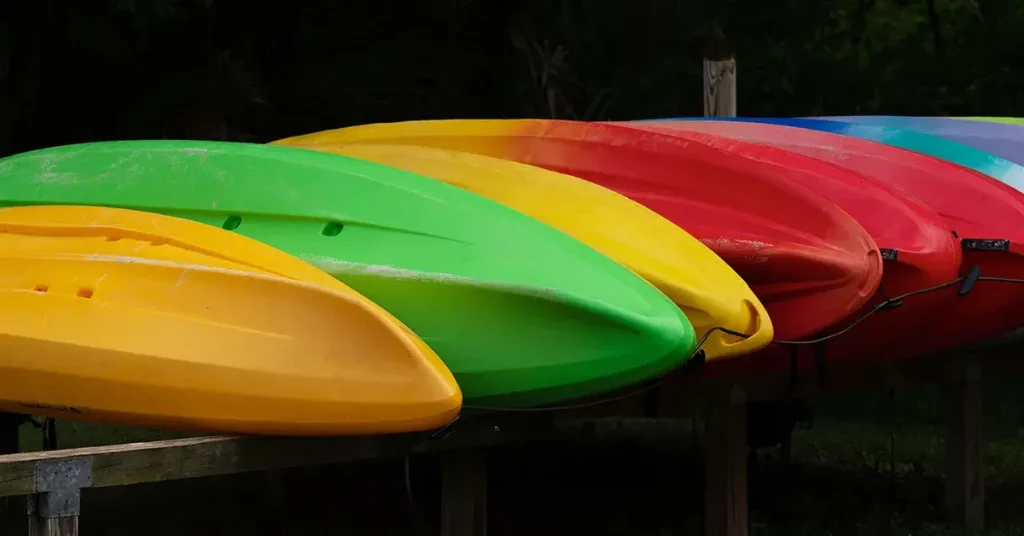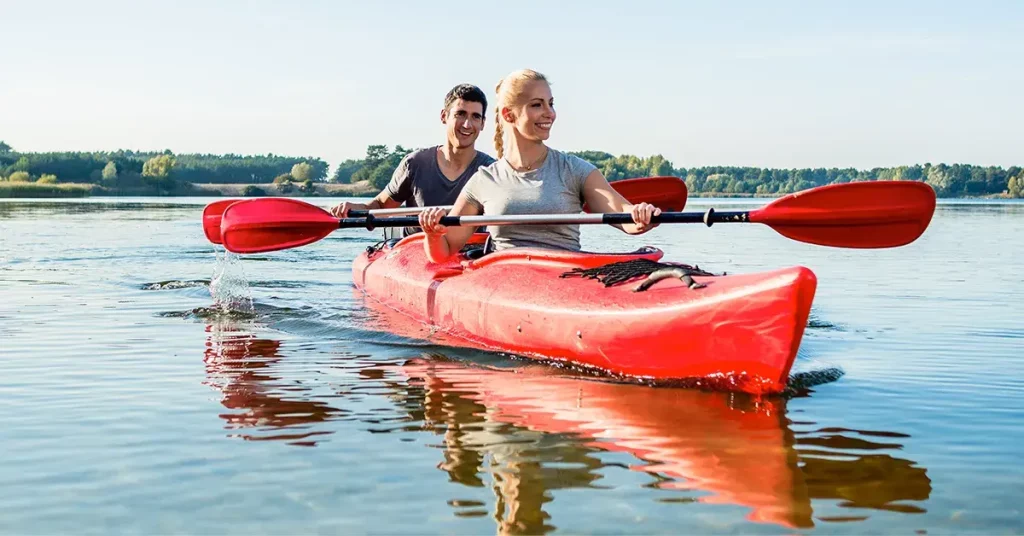Trolling for fish in a canoe or kayak can get pretty tiring! If you’ve ever tried paddling for an entire day, you’ll know exactly what I’m talking about. No matter how fit you are, sooner or later your arms turn to jelly, while you wish you were back on land with a cool drink in hand.
Mounting a trolling motor on your canoe solves this problem. Not only will a trolling motor allow you to rest your weary arms, but you’ll also be able to cover more distance and catch more fish.
There are a variety of trolling motors available for both salt and freshwater usage. Picking the right one for your canoe or kayak can be a confusing task. I’ll break down the types of trolling motors, their features and mounting options – plus how to pick the best one for your boat.
Quick Answer: 5 Best Trolling Motors for your Canoe
- Best Overall: Minn Kota Endura C2 55
- Best Saltwater Trolling Motor: Newport Vessels NV-Series 55lb
- Budget Pick: Newport Vessels NV-Series 36lb
- Short Shaft Trolling Motor: Newport Vessels Kayak Series 55lb
- Best Foot Controlled Trolling Motor: MotorGuide X3
Why do you need a trolling motor for your canoe or kayak
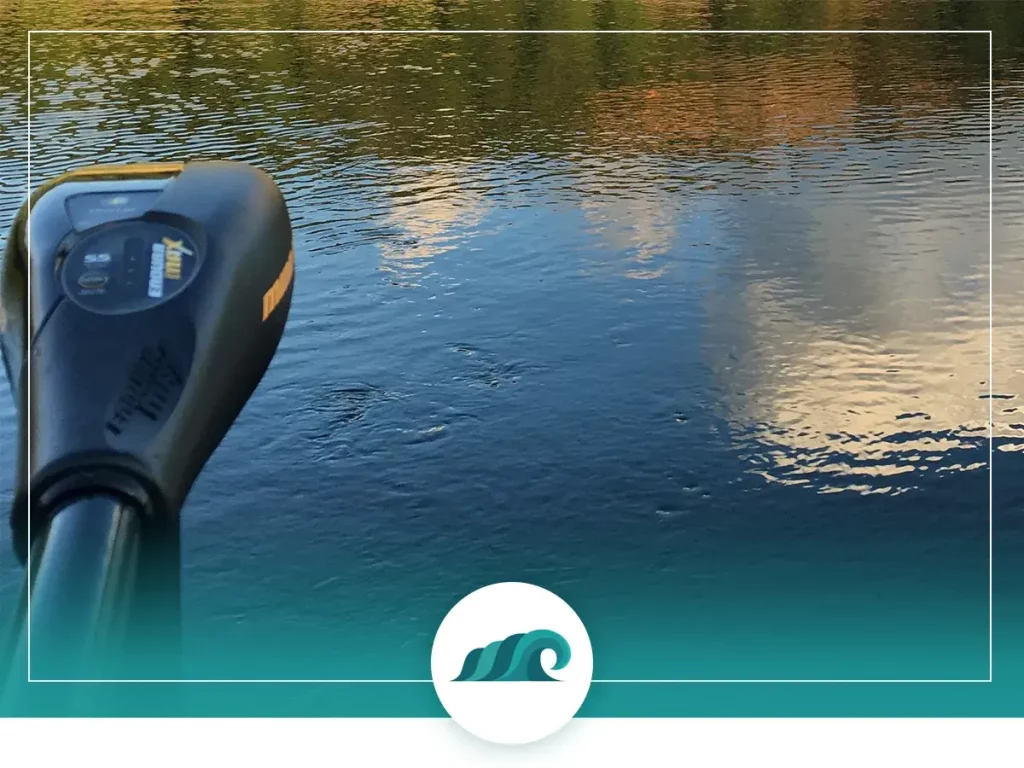
If you’re curious about trolling motors then you might already be familiar with some of their advantages.
A good trolling motor will increase the amount of distance you can cover in your canoe. Paddling is hard work. Your arms and back will eventually get fatigued, which means you’ll have to rest and recuperate from time to time.
A trolling motor allows you to set the motor to your desired speed, just like cruise control in your car. Simply set up your rod and reel, drop your line in the water, and wait for the fish to start biting. Maintaining optimum trolling speed is easier to do with an electric trolling motor than with a paddle or even an outboard motor.
Using a trolling motor also frees up one – or both – of your hands. Trying to maintain a steady speed while paddling and catching fish can be a challenging task. That’s why having a free hand to hold your rod is a huge plus.
Electric trolling motors are relatively quiet and stealthy, allowing you to effortlessly approach fish without spooking them.
In comparison with outboard motors, electric trolling motors are lightweight, less expensive, and can be used in lakes and ponds that are designated “no gas motors allowed”.
More advantages of electric trolling motors:
- Can keep your canoe or kayak in place in a current.
- Can be used as a secondary motor on larger watercraft for precise maneuvering.
- Good backup in case you lose your paddle.
- Great for fishing – helps keep your lure at the ideal depth while trolling.
Best Overall: Minn Kota Endura C2 55
A well-made 12-volt motor from renowned manufactured Minn Kota, this 55 lbs. thrust motor is ideal for all kinds of freshwater usage. It features 5 forward speeds and 3 reverse speeds for maximum control over your craft. The quick-release lever lock bracket easily mounts to any transom and resists flexing, warping and UV damage.
Minn Kota is known for making powerful, quiet motors that last for years. This model is no exception. The composite shaft is virtually indestructible – it’s designed to flex on impact rather than breaking. Minn Kota even guarantees the shaft with a lifetime guarantee. Motor shafts are available in 3 lengths: 30”, 36” and 42”.
The 6-inch telescoping tiller tilts and extends which makes it a breeze to operate.
The entire motor is backed up by a 2-year manufacturer warranty, making this motor a perfect choice for any canoe or kayak in freshwater.
Key Features
- 5 forward speeds, 3 reverse speeds
- Virtually indestructible motor shaft, backed by a lifetime warranty
- Smooth and quiet operation
- Surprisingly powerful and long lasting
- 2-year manufacturer warranty
- Lever Lock Bracket: This solid 10-position bracket features a quick-release lever lock and reinforced composite material that resists flexing, warping, and UV damage
- Telescoping Tiller: Get easy, comfortable, intuitive operation of your trolling motor with the six-inch telescoping tiller.
- 5 Fwd/3 Rev Speed Settings: Five speed settings for forward and three speed settings for reverse.
- Power Prop: For 3-1/4 motor diameters, this prop delivers extra power to push throw heavy vegetation. Includes prop pin, nut and washer.
- Indestructible Composite Shaft — for Life: At the core of your Minn Kota trolling motor is an indestructable composite shaft. Its a Minn Kota exclusive, and we it for life.
View Pricing On:
Best Saltwater Trolling Motor: Newport Vessels NV-Series 55lb
This ultra-quiet 55 lbs. trolling motor is a great choice for both saltwater and freshwater usage. The hardware is made of corrosion resistant stainless steel, zinc and magnesium ensuring the motor can stand up to heavy saltwater use.
5 forward speeds and 3 reverse speeds give you superb control over any watercraft. The 6-inch telescoping handle ensures you can use the motor comfortably for hours at a time.
The 30” composite fiberglass composite shaft is fully adjustable – allowing proper depth placement in all water conditions. Mounting the motor to a canoe or kayak is fairly straightforward with a tilt-adjustable mounting bracket.
A 5-point LED battery meter provides a clear battery reading – so you know how much juice you have left in your battery.
Newport includes a 2-year manufacturer warranty, so you can be assured you’re covered in case anything goes wrong.
Key Features
- Ultra-quiet and efficient motor
- 5-point LED battery meter provides feedback on remaining battery power
- Corrosion-resistant hardware can stand up to saltwater
- 2-year manufacturer’s warranty
- Efficient Power: 55Lb Thrust - This 12V Electric Trolling Motor Provides Excellent Power And Efficiency For Any Boater. The High Quality Build Allows The Motor To Run All Day Long Without Overheating, Or Making Noise To Spook Fish
- Features: This Motor Features A 30 Inch Shaft, A 5 Led Battery Meter, A 6 Inch Telescoping Tiller Handle, And 3 Blade Propeller. The Mount Angle, Height, And Direction Can All Be Adjusted And Locked Into Place When Needed
- Speed: This Motor Has 8 Speeds, 5 Forward And 3 Reverse. The Motor Is Designed For Trolling, So The Top Speed Of This Motor Is About 4Mph, But Depends On Your Boat Shape, Weight, Water, Wind, And Other Factors. Our 3 Blade Propeller Gives The Motor Great Low End Torque To Get The Boat Moving
- Battery: The Nv 55Lb Motor Requires One (1) 12V Lead-Acid Deep Cycle Or Lithium Deep Cycle Battery (Battery Not Included), 50Ah Recommended. The Motor Also Includes A 50Amp Circuit Breaker Which Is Recommended At All Times To Protect From Battery Voltage Surges. Max Amp Draw: 52A
Prices pulled from the Amazon Product Advertising API on:
Product prices and availability are accurate as of the date/time indicated and are subject to change. Any price and availability information displayed on [relevant Amazon Site(s), as applicable] at the time of purchase will apply to the purchase of this product.
Budget Pick: Newport Vessels NV-Series 36lb
If you’re looking for a trolling motor capable of propelling your canoe or kayak without breaking the bank, then this is a great choice. It’s almost identical in design to the Newport Vessels NV-Series 55lb motor, with a 36 lb. thrust motor instead of 55 lb.
The 36 lb. motor provides a good balance between power, efficiency, and affordability. The smaller motor provides longer run-time than bigger motors without sacrificing reliability or performance. Like other Newport Vessels’ motors – it’s ultra-quiet and allows you to approach fish without spooking them.
The motor is controlled with an 8-speed control system (5 forward speeds and 3 reverse speeds), giving you a smooth ride with precise control over speed.
Built with saltwater corrosion resistant materials, this motor allows you the freedom to use in both freshwater and saltwater. A 2-year manufacturer’s warranty comes included.
Key Features
- 36 pound thrust motor offers a good balance between power and run-time
- 2-blade compact propeller for optimal power conservation
- Saltwater corrosion resistant materials
- 5-point LED battery meter
- 36lb thrust - the easy to operate, quiet and cool 36lb nv series allows you to fish all day long without overheating, or scaring away fish.
- 30-inch composite fiberglass shaft - high-strength, fully adjustable shaft allows for proper depth placement in all water conditions.
- 8 speeds and 6-inch telescoping handle (5 forward, 3 reverse) - ergonomic extendable handle, 5 forward speeds, and 3 reverse speeds puts total control at your fingertips for a smooth and controlled ride.
- 5-point led battery meter - super bright battery indicator provides immediate charge level. note: the nv 36lb motor requires one (1) 12v lead-acid deep cycle or marine battery (battery not included).
- saltwater compatible hardware - stainless steel, zinc, and magnesium hardware ensures the motor is ready for fresh or saltwater.
- 2 year warranty - we stand behind every product we make with industry leading customer service and a 2 year warranty.
- Included components: Owner s Manual
Prices pulled from the Amazon Product Advertising API on:
Product prices and availability are accurate as of the date/time indicated and are subject to change. Any price and availability information displayed on [relevant Amazon Site(s), as applicable] at the time of purchase will apply to the purchase of this product.
Short Shaft Trolling Motor: Newport Vessels Kayak Series 55lb
Short shaft motors are ideal for smaller watercraft like kayaks, canoes and inflatable dinghies. The 24” fiberglass shaft offers ideal depth placement on a kayak or small canoe. Extended 5ft 6in battery cables allow for flexible battery placement – which lets you position the battery optimally inside your boat.
5 forward gears and 3 reverse gears provide precise steering and control, while a bright blue LED indicator ensures you know exactly how much run time is left in your battery.
The entire unit is rated for saltwater use, with an aluminum motor head and corrosion resistant magnesium, zinc, and stainless-steel hardware. Its ultra-quiet motor operation allows you to get in close to fish without spooking them – something bigger boats can only dream of.
Newport Vessels backs up the motor with a 2-year manufacturer’s warranty.
Key Features
- 24” short shaft is ideal for kayaks and small watercraft
- Extended battery cables allow optimal battery placement
- Saltwater rated
- Ultra-quiet motor allows you to stealthily approach fish without spooking them
- Kayak Shaft: 24-Inch Fiberglass Shaft Allows For Variable Depth Placement, While Offering A Lifetime Of Dependable Performance
- Variable Speed: 8 Speeds (5 Forward & 3 Reverse) With 6-Inch Telescoping Handle Puts You In Total Control Of Your Ride
- Saltwater Rated: Durable All Aluminum Motor Head W/ Corrosion Resistant Magnesium, Zinc, And Stainless-Steel Hardware For Saltwater Use (Lead-Acid Dc 12V)
- Extra Long Cables: 56 Battery Cables Allow For Versatile Battery Placement For Optimal Weight Distribution
Prices pulled from the Amazon Product Advertising API on:
Product prices and availability are accurate as of the date/time indicated and are subject to change. Any price and availability information displayed on [relevant Amazon Site(s), as applicable] at the time of purchase will apply to the purchase of this product.
Best Foot Controlled Trolling Motor: MotorGuide X3 Bow Mount Foot-Controlled Trolling Motor
This foot-controlled freshwater trolling motor allows for completely hands-free operation, which leaves your hands open to catch more fish.
The motor is made from high-quality materials – a rigid aircraft grade aluminum mount keeps the unit secure while stainless steel bushings and bearings ensure long-term performance. The foot control unit utilizes an ergonomic heel/toe design which allows for precise control over your boat.
A patented variable-ratio steering system lets you accurately position your boat even in choppy, windy conditions. The system works by increasing directional change as you increase pressure on the foot control unit.
Available in 45, 55 and 70 lb. thrust motors, this motor has enough thrust to power larger watercraft, but can be mounted on a bigger canoe as well.
The motor is backed by a 2-year manufacturer’s warranty.
Key Features
- Aircraft grade aluminum mounting bracket minimizes flex
- Rugged composite shaft provides impact protection and has a lifetime warranty
- Precision response steering improves steering responsiveness
- Hands-free operation
- Whisper quiet on the water
- Efficient Power: 55Lb Thrust - This 12V Electric Trolling Motor Provides Excellent Power And Efficiency For Any Boater. The High Quality Build Allows The Motor To Run All Day Long Without Overheating, Or Making Noise To Spook Fish
- Features: This Motor Features A 30 Inch Shaft, A 5 Led Battery Meter, A 6 Inch Telescoping Tiller Handle, And 3 Blade Propeller. The Mount Angle, Height, And Direction Can All Be Adjusted And Locked Into Place When Needed
- Speed: This Motor Has 8 Speeds, 5 Forward And 3 Reverse. The Motor Is Designed For Trolling, So The Top Speed Of This Motor Is About 4Mph, But Depends On Your Boat Shape, Weight, Water, Wind, And Other Factors. Our 3 Blade Propeller Gives The Motor Great Low End Torque To Get The Boat Moving
- Battery: The Nv 55Lb Motor Requires One (1) 12V Lead-Acid Deep Cycle Or Lithium Deep Cycle Battery (Battery Not Included), 50Ah Recommended. The Motor Also Includes A 50Amp Circuit Breaker Which Is Recommended At All Times To Protect From Battery Voltage Surges. Max Amp Draw: 52A
View Pricing On:
What are electric trolling motors
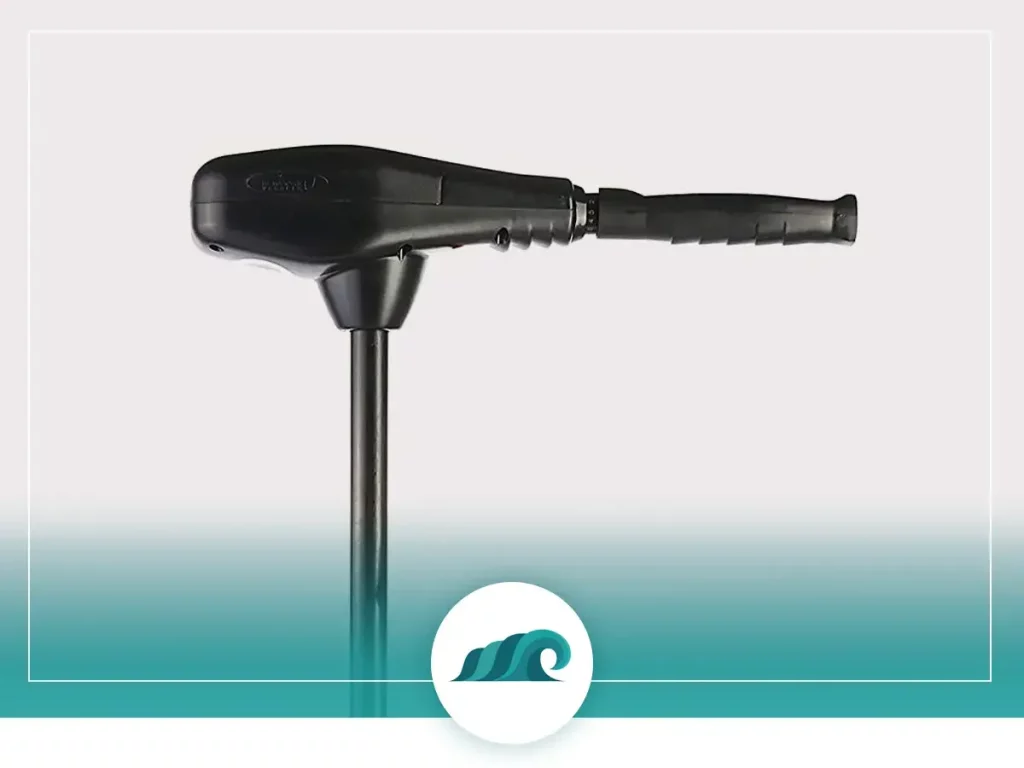
Electric trolling motors are self-contained propulsion units which include a motor, propeller, and controls. They’re mounted on either the bow (front) or stern (rear) of a watercraft. For canoes and kayaks, they’re typically mounted on the stern.
The name “trolling” comes from the fishing technique where fishing lines are drawn through the water by a moving boat. Trolling motors are ideal for fishing but have many other uses as well.
Modern electric trolling motors are highly efficient and can typically operate all day without needing to be recharged. The variable speed controls and reverse allow you to precisely control the speed and direction of your craft. Their lightweight design means you can easily lift the motor out of the water while loading/unloading or if you need to clear obstacles in shallow water.
Trolling Motor Components
Motor
Modern electric trolling motors are typically 12, 24 or 36 volt brushed motors. For canoes, a 12v motor should provide more than enough power for most situations.
The motor itself is mounted inside a watertight compartment at the base of the unit. It’s fully submerged when in use. This design is ideal for lightweight boats like canoes and kayaks, as it takes up less space inside the hull.
Controls
There are three control types typically used in electric trolling motors: Hand control, foot control, and wireless control.
Hand controlled motors are easy to use, relatively inexpensive, and can be mounted directly to your boat. They do require one hand to operate, so if you want hands-free operation look into a foot or remote control.
Foot controlled motors have on/off and speed controls operated by your foot. This allows total hands-free operation, which is great for fishing. They’re typically more expensive than hand controlled motors and are found in motors for larger watercraft. They also require a specialized mounting bracket to install.
Foot controls can be difficult to coordinate for some people, so fishing with them requires a little practice.
Wireless remote controlled motors are the most expensive and are typically found in high-end models. They can be controlled with either a foot pedal or a hand operated remote control.
Propeller
The propeller is fitted directly to the motor’s prop shaft. This means the power coming out of the motor transfers into the propeller without any power reduction. This design leads to increased efficiency, reduced noise, and precise control.
Propellers typically have three blades, but there are some models available with fewer or more blades.
How to pick the right trolling motor for your canoe
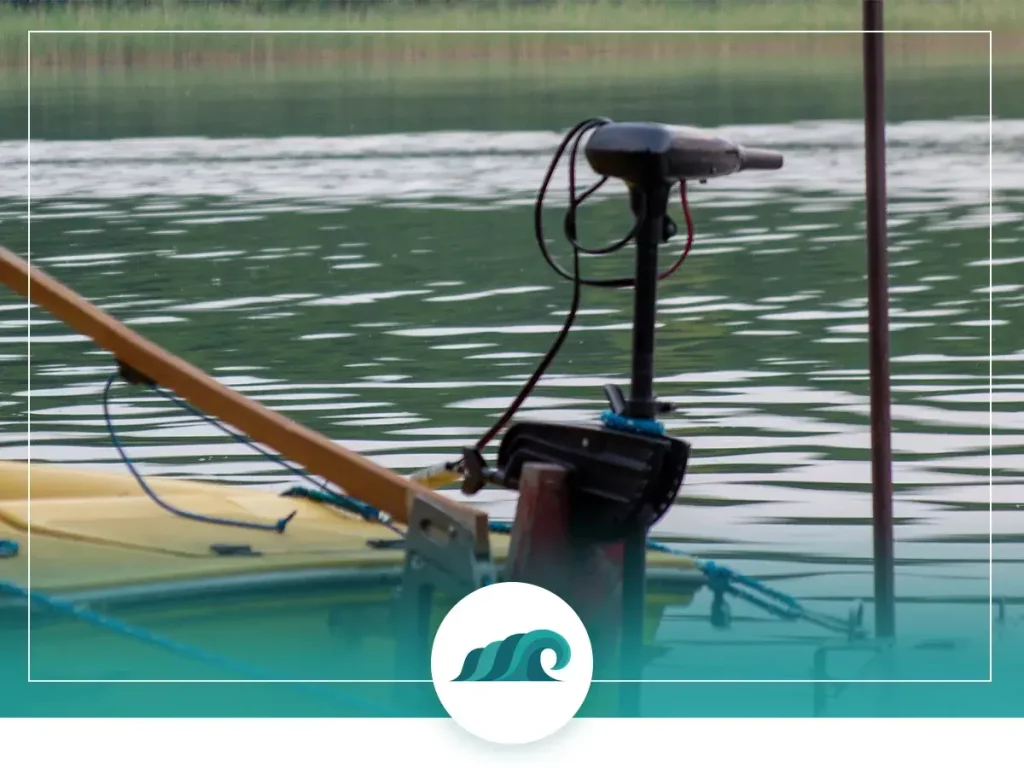
The right trolling motor for your canoe or kayak will depend on a number of factors.
Do you plan to use the motor in saltwater, freshwater or both? How heavy is your watercraft? How much power are you looking for?
Saltwater vs. Freshwater
There are significant differences between the design of saltwater and freshwater motors.
Saltwater motors are typically made with stainless steel hardware, sealed electrical connections and corrosion resistant paint. Freshwater motors do not have these features, so using a freshwater motor in saltwater can cause corrosion and damage the motor.
Using a freshwater motor in saltwater will often void the manufacturer’s warranty. Read the fine print on your motor’s warranty to be sure.
If you do decide to use a freshwater motor in saltwater, be sure to thoroughly rinse the entire motor with fresh water and dry after each use. Spraying with some WD-40 before and after will help protect the motor as well.
Saltwater motors can be used in freshwater without any problems.
Canoe size
The size and weight of your canoe will determine the size motor you’ll need.
For most canoes, a 55-lb thrust motor will provide more than enough power to haul a fully loaded boat. Smaller 30-40 lb thrust motors will work fine for smaller loads, plus they’ll drain your battery at a slower rate.
Shaft Length
The ideal shaft length will place the motor and propeller approximately 1 foot below the water. This length gives you efficient propulsion without being so long that you hit the bottom in shallow water.
Pounds of thrust and voltage
Power from electric trolling motors is rated in pounds of thrust rather than horsepower.
The amount of power you’ll need will depend on the weight of your boat, the wind conditions, and any currents. As a general rule of thumb, select a motor with at least 2lbs. of thrust for every 100lbs. of boat weight.
For most canoes and kayaks, a 55 lb motor will provide more than enough thrust.
Trolling motors are available in several different voltages: 12v, 24v and 36v are common. For a smaller boat, 12v is ideal – it provides enough power while not draining the battery too quickly.
Mounting your trolling motor
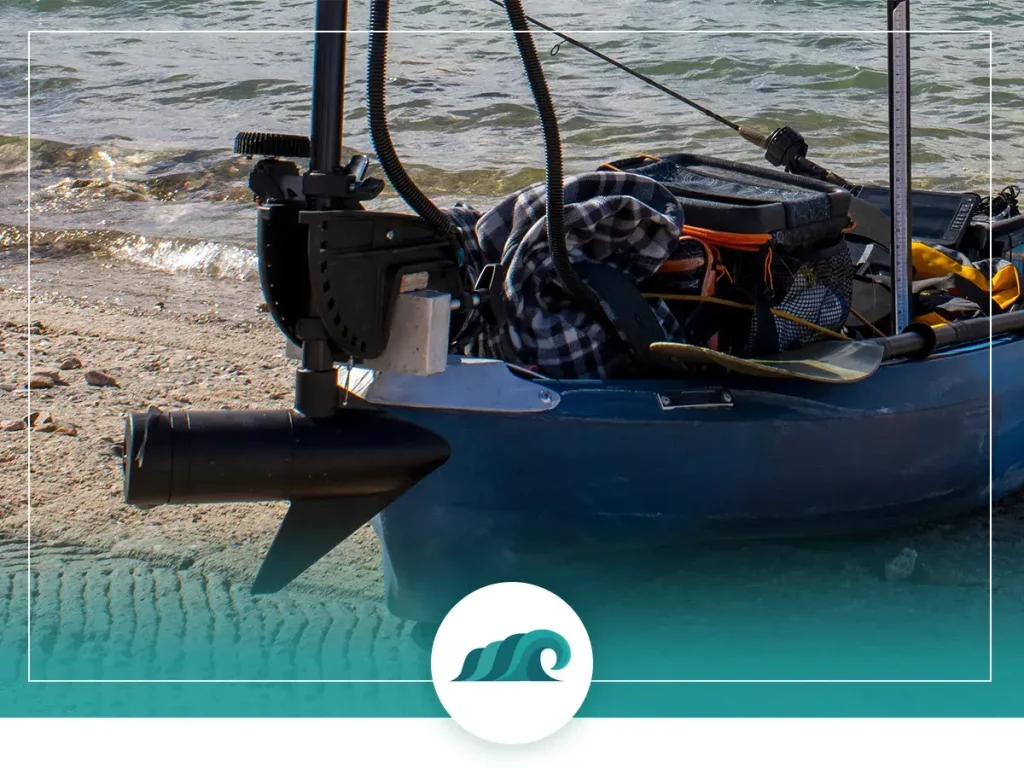
Trolling motors can be mounted in either the bow (front) or stern (rear) of a canoe or kayak. In smaller watercraft, these motors are typically mounted in the stern. This allows easy control over the boat and lets you steer facing forwards.
Larger boats that use a trolling motor as a secondary means of propulsion will often mount in the bow.
Mounting a trolling motor on a canoe is fairly straightforward. Most canoes don’t come with a flat transom (the flat surface forming the stern of a boat) for mounting a motor, but with a 2” x 4”, some steel bolts and a little DIY, you can easily mount a trolling motor to any canoe.
If you don’t want to bother with that, there are also specialized mounting brackets available for canoes and kayaks. They’re typically made of anodized aluminum and are mounted to the gunwales using adjustable angle clamps. These allow you to quickly mount and dismount the motor and rapidly pack everything away for transport.
Maintenance

Trolling motors are generally pretty low maintenance, but following a few key steps will ensure you get the most out of your motor.
- Don’t leave the motor hooked into the power source when not in use for extended periods of time. This can lead to corrosion of the battery terminals.
- Give the motor and propeller a good rinse in fresh water after each use. This is especially important if you use your motor in saltwater.
- Check the propeller for weeds or fishing line that might have become entangled. These can stress your motor and cause it to overwork.
- Apply some marine-friendly lubricant spray to the shaft and all moving parts to keep them well lubricated and protected from corrosion.
- Recharge your battery to full after each use to extend the battery life.
Wrapping it All Up
If you fish from your canoe or kayak frequently, then getting a trolling motor to mount on your boat is a no-brainer.
A trolling motor makes a great addition to any canoe or kayak – it enables you to cover more distance, maintain a constant speed while fishing, and allows you to rest your arms when you get tired of paddling.
Advancements in trolling motor technology have made them cheaper and more efficient than ever before. Modern trolling motors are highly efficient and draw far less battery power than older models.
If you spend a lot of time fishing in the wild, check out my reviews of fishing face masks and survival fishing kits.
FAQ’s
Do you need to register a canoe with a trolling motor?
In most states, you will need to register your canoe when you mount a trolling motor on it. This includes both electric and gas trolling motors.
How long will a battery last with a trolling motor?
This depends on a number of factors, such as the weight of the boat, weather conditions, and age of the motor. A newer model 12-volt motor mounted on a canoe or kayak should last well over 8 hours of moderate usage in normal weather conditions.
How fast will a 55 lbs. thrust trolling motor go?
Top speed will depend on boat weight, hull shape, and length-to-beam ratio. Typically a 55 lbs. trolling motor mounted on a canoe or kayak will top out at 4 – 6 mph.
What kind of battery do you need for a trolling motor?
A deep cycle marine battery is needed for a trolling motor. Car batteries are not appropriate for use with trolling motors; they will not last long and can damage the motor.










